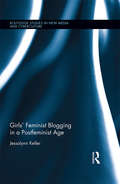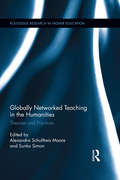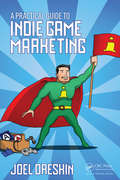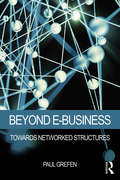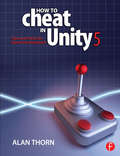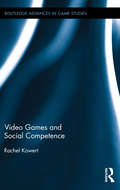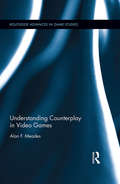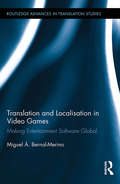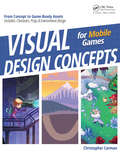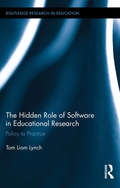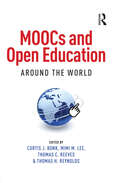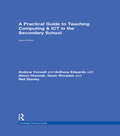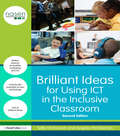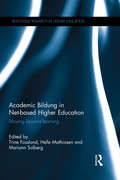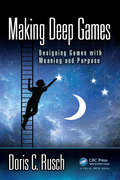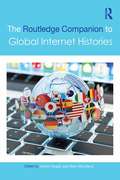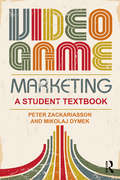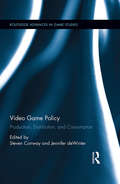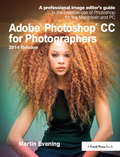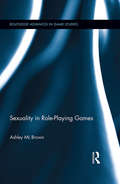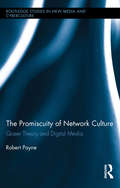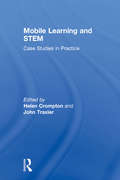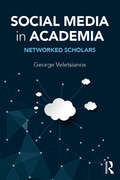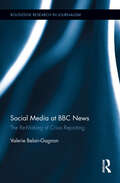- Table View
- List View
Girls' Feminist Blogging in a Postfeminist Age (Routledge Studies in New Media and Cyberculture)
by Jessalynn KellerGirls’ Feminist Blogging in a Postfeminist Age explores the practices of U.S.-based teenage girls who actively maintain feminist blogs and participate in the feminist blogosphere as readers, writers, and commenters on platforms including Blogspot, Facebook, Twitter, and Tumblr. Drawing on interviews with bloggers between the ages of fifteen and twenty-one, as well as discursive textual analyses of feminist blogs and social networking postings authored by teenage girls, Keller addresses how these girls use blogging as a practice to articulate contemporary feminisms and craft their own identities as feminists and activists. In this sense, feminist girl bloggers defy hegemonic postfeminist and neoliberal girlhood subjectivities, a finding that Keller uses to complicate both academic and popular assertions that suggest teenage girls are uninterested in feminism. Instead, Keller maintains that these young bloggers employ digital media production to educate their peers about feminism, connect with like-minded activists, write feminist history, and make feminism visible within popular culture, practices that build upon and continue a lengthy tradition of American feminism into the twenty-first century. Girls’ Feminist Bloggers in a Postfeminist Age challenges readers to not only reconsider teenage girls’ online practices as politically and culturally significant, but to better understand their crucial role in a thriving contemporary feminism.
Globally Networked Teaching in the Humanities: Theories and Practices (Routledge Research in Higher Education)
by Alexandra Schultheis Moore Sunka SimonAs colleges and universities in North America increasingly identify "internationalization" as a key component of the institution’s mission and strategic plans, faculty and administrators are charged with finding innovative and cost-effective approaches to meet those goals. This volume provides an overview and concrete examples of globally-networked learning environments across the humanities from the perspective of all of their stakeholders: teachers, instructional designers, administrators and students. By addressing logistical, technical, pedagogical and intercultural aspects of globally-networked teaching, this volume offers a unique perspective on this form of curricular innovation through internationalization. It speaks directly to the ways in which new technologies and pedagogies can promote humanities-based learning for the future and with it the broader essential skills of intercultural sensitivity, communication and collaboration, and critical thinking.
A Practical Guide to Indie Game Marketing
by Joel DreskinLearn how to market for your indie game, even with a small budget and limited resources. <P><P>For those who want to earn a regular income from making indie games, marketing can be nearly as vital to the success of the game as the game itself. A Practical Guide to Indie Game Marketing provides you with the tools needed to build visibility and sell your game. With special focus on developers with small budgets and limited staff and resources, this book is packed with recommendations and techniques that you can put to use immediately. As a seasoned marketing professional, author Joel Dreskin provides insight into practical, real-world experiences from marketing numerous successful games and also shares tips on mistakes to avoid. Presented in an easy to read format, A Practical Guide to Indie Game Marketing includes information on establishing an audience and increasing visibility so you can build successes with your studio and games. <P><P>Through case studies, examples, guidelines and tips, you will learn best practices for developing plans for your game launches, PR, community engagement, channel promotions and more <P><P>Sample timelines help you determine how long in advance of a launch to prepare your first public communications, when to announce your game, as well as recommended timing for releasing different game assets <P><P>Book also includes marketing checklist 'cheat sheets', dos and don’ts and additional resources
Beyond E-Business: Towards networked structures
by Paul GrefenIn Beyond E-Business: Towards Networked Structures Paul Grefen returns with his tried and tested BOAT framework for e-business, now fully expanded and updated with the very latest overview of digitally connected business; from business models, organization structures and architecture, to information technology. What used to be termed "e-business" is now simply business as usual. Today’s successful organizations are complex; they are part of dynamic business networks built on digital channels, going far beyond traditional e-business. This text provides invaluable insights of modern e-business integrated with networked business, going much further than the usual analysis of traditional e-business texts. Included is coverage of the Big Five—social media, mobile computing, big data, cloud computing, and the internet of things --as well as service-oriented business and technology. This essential text provides a compact roadmap to networked e-business for engineering, information systems or business students as well as professionals in the field.
How to Cheat in Unity 5: Tips and Tricks for Game Development
by Alan ThornLooking to become more efficient using Unity? <P><P>How to Cheat in Unity 5 takes a no-nonsense approach to help you achieve fast and effective results with Unity 5. Geared towards the intermediate user, HTC in Unity 5 provides content beyond what an introductory book offers, and allows you to work more quickly and powerfully in Unity. Packed full with easy-to-follow methods to get the most from Unity, this book explores time-saving features for interface customization and scene management, along with productivity-enhancing ways to work with rendering and optimization. In addition, this book features a companion website at www.alanthorn.net, where you can download the book’s companion files and also watch bonus tutorial video content. <P><P>Learn bite-sized tips and tricks for effective Unity workflows <P><P>Become a more powerful Unity user through interface customization <P><P>Enhance your productivity with rendering tricks, better scene organization and more <P><P>Better understand Unity asset and import workflows <P><P>Learn techniques to save you time and money during development
Video Games and Social Competence (Routledge Advances in Game Studies)
by Rachel KowertDespite their popularity, online video games have been met with suspicion by the popular media and academic community. In particular, there is a growing concern that online video game play may be associated with deficits in social functioning. Due to a lack of empirical consistency, the debate surrounding the potential impact of online video game play on a user’s sociability remains an active one. This book contributes to this debate by exploring the potential impact of online video game involvement on social competence outcomes, theoretically and empirically. Through empirical research, Kowert examines the relationships between online video game involvement, social goals, and social skills and discusses the underlying mechanisms of these effects.
Understanding Counterplay in Video Games (Routledge Advances in Game Studies)
by Alan MeadesThis book offers insight into one of the most problematic and universal issues within multiplayer videogames: antisocial and oppositional play forms such as cheating, player harassment, the use of exploits, illicit game modifications, and system hacking, known collectively as counterplay. Using ethnographic research, Alan Meades not only to gives voice to counterplayers, but reframes counterplay as a complex practice with contradictory motivations that is anything but reducible to simply being hostile to play, players, or commercial videogames. The book offers a grounded and pragmatic exploration of counterplay, framing it as an unavoidable by-product of interaction of mass audiences with compelling and culturally important texts.
Translation and Localisation in Video Games: Making Entertainment Software Global (Routledge Advances in Translation and Interpreting Studies)
by Miguel Bernal-MerinoThis book is a multidisciplinary study of the translation and localisation of video games. It offers a descriptive analysis of the industry – understood as a global phenomenon in entertainment – and aims to explain the norms governing present industry practices, as well as game localisation processes. Additionally, it discusses particular translation issues that are unique to the multichannel nature of video games, in which verbal and nonverbal signs must be cohesively combined with interactivity to achieve maximum playability and immerse players in the game’s virtual world. Although positioned within the theoretical framework of descriptive translation studies, Bernal-Merino incorporates research from audiovisual translation, software localisation, computer assisted translation, comparative literature, and video game production. Moving beyond this framework, Translation and Localisation in Video Games challenges some of the basic tenets of translation studies and proposes changes to established and unsatisfactory processes in the video game and language services industries.
Visual Design Concepts For Mobile Games
by Chirstopher P CarmanThis book is geared towards both students as well as professionals who are looking to enter the mobile (tablet/smartphone) and PC (personal computer) industry as concept artists (for both 2D and 3D production pipelines) or 2D production artists (game-ready assets). This book is not specifically focused on game design or game development and is also not a 3D modeling or animation guide. However, certain aspects of game design, game development, and 3D modeling and animation will impact the visual development and art creation process. So, at points throughout we will explore topics such as game engine performance and game mechanics, though at a very high-level, bird's-eye, vantage point and only as they pertain to the visual development of the various assignments throughout this book. Through the completion of the exercises and assignments contained within Visual Development for Web & Mobile Games readers will be guided through the visual development process and execution of a variety of concepts and assets (final game art). This includes categories such as characters, props, and backgrounds, within an isometric design template. The categories themselves will relate more to their function within a very simple game design template than their completed visual representation (e.g., the "big build-able" category could be anything from a town square to a fire breathing dragon as long as it fits within the bare bones parameters of the asset types functionality). The concept, theme, and style of these assets, as well as the world they inhabit, will be completely up to the individual artist. Key Features Weaves knowledge of classic visual development principles and web/mobile game art production practices. Assignments and exercises at the end of every chapter allow the reader to create a game art project from start to finish. Examines both 2D/3D game art pipelines. Includes a companion website with project files, asset downloads & author created video tutorials.
The Hidden Role of Software in Educational Research: Policy to Practice (Routledge Research in Education #143)
by Tom Liam LynchEducational research often discounts the uniqueness and ubiquity of software and the hidden political, economic and epistemological ways it impacts teaching and learning in K-12 settings. Drawing on theories and methodologies from English education, critical discourse analysis, multimodal semiotics and digital humanities, this volume exposes the problems of technology in schools and refocuses the conversation on software. This shifting of focus invites more nuanced questions concerning the role of software in school reform and classroom instruction, and takes a critical stance on software’s role in education. This volume explores the ontology of software and the ways it is construed within educational policy discussions. It is beneficial to schools, companies, policy makers and practitioners seeking a more theoretical framework for technology in education.
MOOCs and Open Education Around the World
by Thomas C. Reeves Curtis J. Bonk Mimi M. Lee Thomas H. ReynoldsAs new digital forms of formal and informal learning proliferate, there is an increasing need to better understand how people in different regions of the world are implementing massive open online courses (MOOCs) and other forms of open educational resources (OERs). Educators, researchers, politicians, and numerous other stakeholders want to grasp what the outcomes of these initiatives are and how they can be improved. Ongoing e-learning developments related to both technology and pedagogy have pushed institutions and organizations to grapple with issues of accreditation, credentialing, quality standards, innovative assessment, and learner motivation and attrition, among other areas of concern. In response, MOOCs and Open Education Around the World explores and illuminates unique implementations of MOOCs and open education across regions and nations. The book also focuses on the various opportunities as well as the dilemmas presented in this rapidly evolving age of technology-enabled learning. What are the different delivery formats, interaction possibilities, assessment schemes, and business models? What are the key controversies or issues that must be discussed and addressed? This edited collection explains MOOCs and open education trends and issues in a variety of contexts, shares key research findings, and provides practical suggestions and recommendations for the near future.
A Practical Guide to Teaching Computing and ICT in the Secondary School (Routledge Teaching Guides)
by Andrew Connell Neil Stanley Anthony Edwards Alison Hramiak Gavin RhoadesA Practical Guide to Teaching Computing and ICT in the Secondary School offers straightforward guidance and inspiration to support all trainee and newly qualified teachers, as well as their tutors and mentors. It will also be a source of support and ideas for qualified teachers who wish to develop their teaching of Computing as a subject, in light of recent changes to the National Curriculum. Grounded in the best research and practice available, it focuses on the key pedagogical issues which arise during teacher training and offers stimulating activities based on tried and tested strategies. Comprehensively updated and restructured to reflect recent changes in the curriculum, Initial Teacher Training Standards and classroom technologies, it covers key aspects of Computing and ICT teaching: Planning pupil learning and progression Managing the learning environment Using assessment to improve pupil learning and your own teaching Developing pupils’ understanding of key concepts and ideas in Computing, including Computational Thinking and Programming Pupils’ common misconceptions and how to avoid them Helping pupils appreciate good and bad effects of computing. A Practical Guide to Teaching Computing and ICT in the Secondary School, written by experts in the field, provides detailed examples of theory in practice, enabling you to analyse and reflect on your own teaching in order to ensure pupil learning is maximised.
Alternative Photographic Processes: Crafting Handmade Images (Alternative Process Photography)
by Brady WilksAlternative Photographic Processes teaches techniques, both analog & digital, allowing artists to bring a personal touch through manipulation of a photograph, the negative, and the print. This book stands apart from recent publications on alternative processes by presenting a range of new approaches and methods to achieve popular techniques, as well as providing step-by-step guidance for an array of unique techniques meant to inspire artists working in various mediums. Through detailed guidance, working artist examples, and info about the contemporary use of these processes, this book will provide instruction for students, educators, and artists to expand their creative toolbox.
Brilliant Ideas for Using ICT in the Inclusive Classroom (David Fulton / Nasen Ser.)
by Sally McKeown Angela McGlashonRunner up in Teach Secondary’s Technology and Innovation Awards 2014 sponsored by Lego, Brilliant Ideas for using ICT in the Inclusive Classroom provides lots of simple practical ideas showing teachers and support staff how they can use ICT to boost the achievement of all pupils. How can you use ICT to boost the achievement of all your pupils? This practical teachers’ guide will help you to unlock the enormous potential of new technology in order to enhance pupils’ learning, particularly for young people with additional needs. Written by two of the UK’s leading technology experts, this invaluable and newly updated resource will enable you to use ICT effectively to make lessons more accessible, motivating and fun. With fifty illustrated case studies and twenty starter activities, this practical resource will help you to introduce new technology into the inclusive classroom. It has been specifically designed to help develop your pupils’ key skills, such as problem solving, developing concepts and communicating to different audiences. In each activity, the authors show why and how a particular resource was used and show how similar techniques can be implemented to open up the curriculum to your learners. The authors include timely and realistic advice on how to use a range of technologies from the cheap and cheerful – and even free – to more sophisticated and specialist packages. Find out about: Apps Blogging Digital animation Podcasting Digital storytelling Wikis Geocaching Coding Games and gaming Sat nav Art packages Twitter Whether you’re already techno-savvy or looking to get started with ICT, this book is full of brilliant ideas on how to engage learners of all abilities using technology. If you’re looking for inspiration on how to integrate creative uses of ICT with the curriculum, this book will prove invaluable.
Academic Bildung in Net-based Higher Education: Moving beyond learning (Routledge Research in Higher Education)
by Trine Fossland Helle Mathiasen Mariann SolbergThe explosive emergence of net-based learning in higher education brings with it new possibilities and constraints in teaching and learning environments.This edited collection considers how the concept of Academic Bildung - a term suggesting a personal educational process beyond actual educational learning - can be applied to net-based higher education. The book is drawing on Scandinavian research to address the topic from both a theoretical and practical standpoint.Chapters explore the facilitation of online courses and argue how and why universities should involve dimensions of Academic Bildung on both a strategic and technological pedagogical content level. The book is structured in three parts: Part I frames the current state of net-based learning and introduces Bildung as a concept; Part II contains a set of four case studies in Norway, Sweden and Denmark, also including a fifth study that looks at Scandinavian approaches to teaching and learning in comparison with data from the USA, the UK, Australia and Canada; Part III provides a synthesis of theories and cases to examine whether a Scandinavian orientation can be discerned. Contributions suggest that in order to address one of the fundamental functions of higher education, the ability to produce new knowledge, the Academic Bildung of the students has to be in focus. Grounded in theoretical and empirical discussion, this book will appeal to researchers and academics in the field of higher education as well as personnel who work with teaching and learning with technology, and academics interested in the question of Academic Bildung.
Making Deep Games: Designing Games with Meaning and Purpose
by Doris C. RuschLike movies, television, and other preceding forms of media, video games are undergoing a dynamic shift in its content and perception. While the medium can still be considered in its infancy, the mark of true artistry and conceptual depth is detectable in the evolving styles, various genres and game themes. Doris C. Rusch’s, Making Deep Games, combines this insight along with the discussion of the expressive nature of games, various case studies, and hands-on design exercises. This book offers a perspective into how to make games that tackle the whole bandwidth of the human experience; games that teach us something about ourselves, enable thought-provoking, emotionally rich experiences and promote personal and social change. Grounded in cognitive linguistics, game studies and the reflective practice of game design, Making Deep Games explores systematic approaches for how to approach complex abstract concepts, inner processes, and emotions through the specific means of the medium. It aims to shed light on how to make the multifaceted aspects of the human condition tangible through gameplay experiences.
The Routledge Companion to Global Internet Histories (Routledge Media and Cultural Studies Companions)
by Gerard Goggin Mark MclellandThe Routledge Companion to Global Internet Histories brings together research on the diverse Internet histories that have evolved in different regions, language cultures and social contexts across the globe. While the Internet is now in its fifth decade, the understanding and formulation of its histories outside of an anglophone framework is still very much in its infancy. From Tunisia to Taiwan, this volume emphasizes the importance of understanding and formulating Internet histories outside of the anglophone case studies and theoretical paradigms that have thus far dominated academic scholarship on Internet history. Interdisciplinary in scope, the collection offers a variety of historical lenses on the development of the Internet: as a new communication technology seen in the context of older technologies; as a new form of sociality read alongside previous technologically mediated means of relating; and as a new media "vehicle" for the communication of content.
Video Game Marketing: A student textbook
by Peter Zackariasson Mikolaj DymekThe video game industry has been one of the fastest-growing cultural phenomena of our times with market conditions that demand a specific skill set from its marketers. To a new generation of "indie gamers", being a game developer isn’t just about design and production, a successful video game demands entrepreneurial skills and astute business acumen. The creators need to know what their customers want, how to reach those customers and how to sell to them. Video Game Marketing: A student textbook is for development students or aspiring developers who want to know how to promote and sell the results of their efforts. This book is a much-needed guide to: • the essentials of marketing strategy; • video games as products or services; • marketing research for game development; • branding video games; • marketing through game: gamification, advergames. Replete with pedagogy to aid learning such as objectives and discussion questions for each chapter, this book is all that aspiring video game developers will need to unleash the potential of their games.
Video Game Policy: Production, Distribution, and Consumption (Routledge Advances in Game Studies)
by Steven Conway and Jennifer deWinterThis book analyzes the effect of policy on the digital game complex: government, industry, corporations, distributors, players, and the like. Contributors argue that digital games are not created nor consumed outside of the complex power relationships that dictate the full production and distribution cycles, and that we need to consider those relationships in order to effectively "read" and analyze digital games. Through examining a selection of policies, e.g. the Australian government’s refusal (until recently) to allow an R18 rating for digital games, Blizzard’s policy in regards to intellectual property, Electronic Arts’ corporate policy for downloadable content (DLC), they show how policy, that is to say the rules governing the production, distribution and consumption of digital games, has a tangible effect upon our understanding of the digital game medium.
Adobe Photoshop CC for Photographers, 2014 Release: A professional image editor's guide to the creative use of Photoshop for the Macintosh and PC
by Martin EveningAdobe Photoshop for Photographers 2014 Release by Photoshop hall-of-famer and acclaimed digital imaging professional Martin Evening has been fully updated to include detailed instruction for all of the updates to Photoshop CC 2014 on Adobe’s Creative Cloud, including significant new features, such as Focus Area selections, enhanced Content-Aware filling, and new Spin and Path blur gallery effects. This guide covers all the tools and techniques photographers and professional image editors need to know when using Photoshop, from workflow guidance to core skills to advanced techniques for professional results. Using clear, succinct instruction and real world examples, this guide is the essential reference for Photoshop users of all levels. Accompanying the book is the photoshopforphotographers.com website, with sample images, tutorial videos, and bonus chapters.
Sexuality in Role-Playing Games (Routledge Advances in Game Studies)
by Ashley ML BrownRole-playing games offer a chance to pretend, make believe, and share fantasy. They often invoke heavy themes into their game play: morality, violence, politics, spirituality, or sexuality. Although interesting moral debates perennially appear in the media and academia concerning the appropriateness of games’ ability to deal with such adult concepts, very little is known about the intersection between games, playfulness, and sexuality and what this might mean for players. This book offers an in-depth, ethnographic look into the phenomenon of erotic role-play through the experiences of players in multiplayer and tabletop role-playing games. Brown explores why participants engage in erotic role-play; discusses the rules involved in erotic role-play; and uncovers what playing with sexuality in ludic environments means for players, their partners, and their everyday lives. Taken together, this book provides a rich, nuanced, and detailed account of a provocative topic.
The Promiscuity of Network Culture: Queer Theory and Digital Media (Routledge Studies in New Media and Cyberculture)
by Robert PayneLiking, sharing, friending, going viral: what would it mean to recognize these current modes of media interaction as promiscuous? In a contemporary network culture characterized by a proliferation of new forms of intimate mediated sociality, this book argues that promiscuity is a new standard of user engagement. Intimate relations among media users and between users and their media are increasingly structured by an entrepreneurial logic and put to work for the economic interests of media corporations. But these multiple intimacies can also be understood as technologies of promiscuous desire serving both to liberalize mediated social connection and to contain it within normative frames of value. Payne brings crucial questions of gender, sexuality, intimacy, and attention back into conversation with recent thinking on network culture and social media, identifying the queer undercurrents of these current media dynamics.
Mobile Learning and STEM: Case Studies in Practice
by Helen Crompton John TraxlerIn recent years, there has been a renewed focus on STEM education in the United States, fueled by evidence that young learners’ competencies in science, technology, engineering, and mathematics are falling behind those of their global peers. Scholars and practitioners are beginning to utilize the new pedagogical opportunities offered by mobile learning to improve the successes of teachers and K-12 students across STEM subjects. Mobile Learning and STEM: Case Studies in Practice is a comprehensive collection of case studies that explore mobile learning’s support of STEM subjects and that utilize mobile technology to facilitate unique and effective K-12 teaching and learning experiences. In addition to its focus on STEM achievement for researchers, this volume is a resource for teachers working to implement mobile learning initiatives into their classrooms. Mobile Learning and STEM also includes research that is applicable to classrooms in nations around the world, where few students from underrepresented racial and socioeconomic backgrounds are entering into STEM jobs. Concluding with a summary of its research and its implications to future scholarship and practice, this book is a springboard for practitioners, specialists, higher education instructors, and researchers who want to establish better practices in schools and raise student achievement in STEM subjects.
Social Media in Academia: Networked Scholars
by George VeletsianosSocial media and online social networks are expected to transform academia and the scholarly process. However, intense emotions permeate scholars’ online practices and an increasing number of academics are finding themselves in trouble in networked spaces. In reality, the evidence describing scholars’ experiences in online social networks and social media is fragmented. As a result, the ways that social media are used and experienced by scholars are not well understood. Social Media in Academia examines the day-to-day realities of social media and online networks for scholarship and illuminates the opportunities, tensions, conflicts, and inequities that exist in these spaces. The book concludes with suggestions for institutions, individual scholars, and doctoral students regarding online participation, social media, networked practice, and public scholarship.
Social Media at BBC News: The Re-Making of Crisis Reporting (Routledge Research in Journalism)
by Valerie Belair-GagnonSince the emergence of social media in the journalistic landscape, the BBC has sought to produce reporting more connected to its audience while retaining its authority as a public broadcaster in crisis reporting. Using empirical analysis of crisis news production at the BBC, this book shows that the emergence of social media at the BBC and the need to manage this kind of material led to a new media logic in which tech-savvy journalists take on a new centrality in the newsroom. In this changed context, the politico-economic and socio-cultural logic have led to a more connected newsroom involving this new breed of journalists and BBC audience. This examination of news production events shows that in the midst of transformations in journalistic practices and norms, including newsgathering, sourcing, distribution and impartiality, the BBC has reasserted its authority as a public broadcaster. Click here for a short video about the book.
